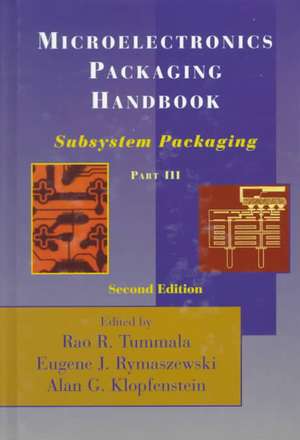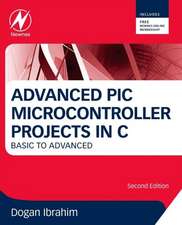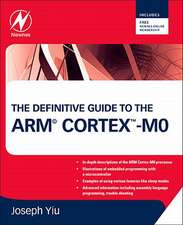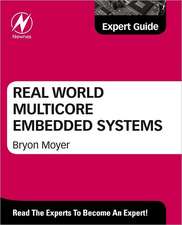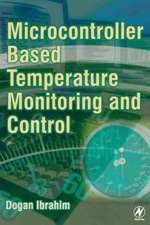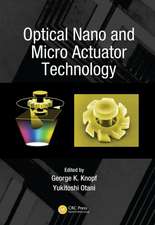Microelectronics Packaging Handbook: Subsystem Packaging Part III
Autor R.R. Tummala, Eugene J. Rymaszewski, Alan G. Klopfensteinen Limba Engleză Hardback – 30 ian 1997
Part I: Technology Drivers covers the driving force of microelectronics packaging - electrical, thermal, and reliability. It introduces the technology developer to aspects of manufacturing that must be considered during product development.
Part II: Semiconductor Packaging discusses the interconnection of the IC chip to the first level of packaging and all first level packages. Electrical test, sealing, and encapsulation technologies are also covered in detail.
Part III: Subsystem Packaging explores board level packaging as well as connectors, cables, and optical packaging.
| Toate formatele și edițiile | Preț | Express |
|---|---|---|
| Paperback (1) | 1238.23 lei 6-8 săpt. | |
| Springer Us – 23 oct 2012 | 1238.23 lei 6-8 săpt. | |
| Hardback (3) | 1007.94 lei 6-8 săpt. | |
| Springer Us – 30 ian 1997 | 1007.94 lei 6-8 săpt. | |
| Springer Us – 31 ian 1997 | 1240.16 lei 6-8 săpt. | |
| Springer Us – 30 ian 1997 | 2223.77 lei 6-8 săpt. |
Preț: 1007.94 lei
Preț vechi: 1259.92 lei
-20% Nou
Puncte Express: 1512
Preț estimativ în valută:
192.86€ • 201.39$ • 159.26£
192.86€ • 201.39$ • 159.26£
Carte tipărită la comandă
Livrare economică 15-29 aprilie
Preluare comenzi: 021 569.72.76
Specificații
ISBN-13: 9780412084515
ISBN-10: 0412084511
Pagini: 628
Ilustrații: XXIX, 628 p.
Dimensiuni: 155 x 235 x 43 mm
Greutate: 0.99 kg
Ediția:2nd ed. 1997
Editura: Springer Us
Colecția Springer
Locul publicării:New York, NY, United States
ISBN-10: 0412084511
Pagini: 628
Ilustrații: XXIX, 628 p.
Dimensiuni: 155 x 235 x 43 mm
Greutate: 0.99 kg
Ediția:2nd ed. 1997
Editura: Springer Us
Colecția Springer
Locul publicării:New York, NY, United States
Public țintă
ResearchCuprins
Part I: Foreword. Preface. Conversion Factors. Summary Contents. 1. Microelectronics packaging: An overview. 2. Package wiring and terminals. 3. Package electrical design. 4. Heat transfer in electronic packages. 5. Package reliability. 6. Package manufacture. Glossary and Symbols. Authors' Biographies. Index. Part II: 7. Microelectronics packaging: An overview. 8. Chip-to-package interconnection. 9. Ceramic packaging. 10. Plastic packaging. 11. Polymers in packaging. 12. Thin-film packaging. 13. Package electrical testing. 14. Package sealing and encapsulation. Part III: 15. Microelectronics packaging: An overview. 16. Package-to-board interconnections. 17. Printed-wiring board packaging. 18. Coated-metal packaging. 19. Connector and cable packaging. 20. Packaging of optoelectronics with electronics.
Recenzii
`A most comprehensive book set, both well presented and well illustrated.'
IEEE Electrical Insulation Magazine, September/October 1997
IEEE Electrical Insulation Magazine, September/October 1997
Descriere
Descriere de la o altă ediție sau format:
Electronics has become the largest industry, surpassing agriculture, auto, and heavy metal industries. It has become the industry of choice for a country to prosper, already having given rise to the phenomenal prosperity of Japan, Korea, Singapore, Hong Kong, and Ireland among others. At the current growth rate, total worldwide semiconductor sales will reach $300B by the year 2000. The key electronic technologies responsible for the growth of the industry include semiconductors, the packaging of semiconductors for systems use in auto, telecom, computer, consumer, aerospace, and medical industries, displays, magnetic, and optical storage as well as software and system technologies. There has been a paradigm shift, however, in these technologies, from mainframe and supercomputer applications at any cost, to consumer applications at approximately one-tenth the cost and size. Personal computers are a good example, going from $500IMIP when products were first introduced in 1981, to a projected $IIMIP within 10 years. Thin, light portable, user friendly and very low-cost are, therefore, the attributes of tomorrow's computing and communications systems. Electronic packaging is defined as interconnection, powering, cool ing, and protecting semiconductor chips for reliable systems. It is a key enabling technology achieving the requirements for reducing the size and cost at the system and product level.
Electronics has become the largest industry, surpassing agriculture, auto, and heavy metal industries. It has become the industry of choice for a country to prosper, already having given rise to the phenomenal prosperity of Japan, Korea, Singapore, Hong Kong, and Ireland among others. At the current growth rate, total worldwide semiconductor sales will reach $300B by the year 2000. The key electronic technologies responsible for the growth of the industry include semiconductors, the packaging of semiconductors for systems use in auto, telecom, computer, consumer, aerospace, and medical industries, displays, magnetic, and optical storage as well as software and system technologies. There has been a paradigm shift, however, in these technologies, from mainframe and supercomputer applications at any cost, to consumer applications at approximately one-tenth the cost and size. Personal computers are a good example, going from $500IMIP when products were first introduced in 1981, to a projected $IIMIP within 10 years. Thin, light portable, user friendly and very low-cost are, therefore, the attributes of tomorrow's computing and communications systems. Electronic packaging is defined as interconnection, powering, cool ing, and protecting semiconductor chips for reliable systems. It is a key enabling technology achieving the requirements for reducing the size and cost at the system and product level.
